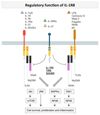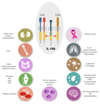Tuning inflammation and immunity by the negative regulators IL-1R2 and IL-1R8
- PMID: 29247989
- PMCID: PMC5922415
- DOI: 10.1111/imr.12609
Tuning inflammation and immunity by the negative regulators IL-1R2 and IL-1R8
Abstract
Interleukin-1 receptor family members (ILRs) and Toll-Like Receptors (TLRs) are key players in immunity and inflammation and are tightly regulated at different levels. Most cell types, including cells of the innate and adaptive immune system express ILRs and TLRs. In addition, IL-1 family members are emerging as key players in the differentiation and function of innate and adaptive lymphoid cells. IL-1R2 and IL-1R8 (also known as TIR8 or SIGIRR) are members of the ILR family acting as negative regulators of the IL-1 system. IL-1R2 binds IL-1 and the accessory protein IL-1RAcP without activating signaling and can be released as a soluble form (sIL-1R2), thus modulating IL-1 availability for the signaling receptor. IL-1R8 dampens ILR- and TLR-mediated cell activation and it is a component of the receptor recognizing human IL-37. Here, we summarize our current understanding of the structure and function of IL-1R2 and IL-1R8, focusing on their role in different pathological conditions, ranging from infectious and sterile inflammation, to autoimmunity and cancer-related inflammation. We also address the emerging evidence regarding the role of IL-1R8 as a crucial checkpoint molecule in NK cells in anti-cancer and antiviral activity and the potential therapeutic implications of IL-1R8 blockade in specific pathological contexts.
Keywords: infection; inflammation; inflammation-associated cancer; interleukin-1.
© 2017 John Wiley & Sons A/S. Published by John Wiley & Sons Ltd.
Conflict of interest statement
The authors declare no conflicts of interest.
Figures



Similar articles
-
Regulatory Role of IL-1R8 in Immunity and Disease.Front Immunol. 2016 Apr 20;7:149. doi: 10.3389/fimmu.2016.00149. eCollection 2016. Front Immunol. 2016. PMID: 27148268 Free PMC article. Review.
-
IL-1R8: A molecular brake of anti-tumor and anti-viral activity of NK cells and ILC.Semin Immunol. 2023 Mar;66:101712. doi: 10.1016/j.smim.2023.101712. Epub 2023 Feb 6. Semin Immunol. 2023. PMID: 36753974 Review.
-
Negative Regulation of the IL-1 System by IL-1R2 and IL-1R8: Relevance in Pathophysiology and Disease.Front Immunol. 2022 Feb 8;13:804641. doi: 10.3389/fimmu.2022.804641. eCollection 2022. Front Immunol. 2022. PMID: 35211118 Free PMC article. Review.
-
TIR8/SIGIRR is an Interleukin-1 Receptor/Toll Like Receptor Family Member with Regulatory Functions in Inflammation and Immunity.Front Immunol. 2012 Oct 29;3:322. doi: 10.3389/fimmu.2012.00322. eCollection 2012. Front Immunol. 2012. PMID: 23112799 Free PMC article.
-
High IL-1R8 expression in breast tumors promotes tumor growth and contributes to impaired antitumor immunity.Oncotarget. 2017 Jul 25;8(30):49470-49483. doi: 10.18632/oncotarget.17713. Oncotarget. 2017. PMID: 28533483 Free PMC article.
Cited by
-
IL-37: An anti-inflammatory cytokine with antitumor functions.Cancer Rep (Hoboken). 2019 Apr;2(2):e1151. doi: 10.1002/cnr2.1151. Epub 2018 Nov 22. Cancer Rep (Hoboken). 2019. PMID: 32935478 Free PMC article. Review.
-
Identification of Potential Biomarkers and Immune Infiltration Characteristics in Idiopathic Pulmonary Arterial Hypertension Using Bioinformatics Analysis.Front Cardiovasc Med. 2021 Feb 1;8:624714. doi: 10.3389/fcvm.2021.624714. eCollection 2021. Front Cardiovasc Med. 2021. PMID: 33598484 Free PMC article.
-
Soluble interleukin-1 receptor type 2 plasma levels in Parkinson's disease: relationship with cardiac autonomic profile before and after peripheral mechanical somatosensory stimulation.Front Physiol. 2023 Aug 16;14:1168652. doi: 10.3389/fphys.2023.1168652. eCollection 2023. Front Physiol. 2023. PMID: 37664433 Free PMC article.
-
The Role of Interleukin-1 in the Pathogenesis of Cancer and its Potential as a Therapeutic Target in Clinical Practice.Oncol Ther. 2018 Dec;6(2):109-127. doi: 10.1007/s40487-018-0089-z. Epub 2018 Nov 28. Oncol Ther. 2018. PMID: 32700032 Free PMC article. Review.
-
IL-33, an Alarmin of the IL-1 Family Involved in Allergic and Non Allergic Inflammation: Focus on the Mechanisms of Regulation of Its Activity.Cells. 2021 Dec 30;11(1):107. doi: 10.3390/cells11010107. Cells. 2021. PMID: 35011670 Free PMC article. Review.
References
-
- Kang JY, Lee JO. Structural biology of the Toll-like receptor family. Annu Rev Biochem. 2011;80:917–941. - PubMed
-
- O'Neill LA. How Toll-like receptors signal: what we know and what we don't know. Curr Opin Immunol. 2006;18:3–9. - PubMed
-
- O'Neill LA. The interleukin-1 receptor/Toll-like receptor superfamily: 10 years of progress. Immunol Rev. 2008;226:10–18. - PubMed
Publication types
MeSH terms
Substances
Associated data
- Actions
- Actions
- Actions
- Actions
- Actions
- Actions
Grants and funding
LinkOut - more resources
Full Text Sources
Other Literature Sources

